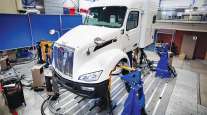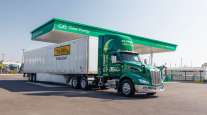Peterbilt Showcases Electric Vehicles

[Stay on top of transportation news: Get TTNews in your inbox.]
SONOMA, Calif. — Peterbilt is working with its dealers and customers to deploy end-to-end solutions for electric vehicle applications and meet regulatory requirements, including the California Air Resources Board’s Advanced Clean Fleet, Advanced Clean Truck and low NOx regulations.
The manufacturer shared its latest initiatives and demonstrated several models of electric and diesel trucks at its 2024 Commitment to Class event Aug. 7-9.
Jim Wallace, director of medium-duty for Peterbilt, said the truck maker’s current lineup “represents individualized solutions for your applications in every industry for every job.”
U.S. and Canada truck industry retail sales are estimated to be 240,000 to 280,000 for Class 8 this year, and the medium-duty industry is estimated to be slightly more than 100,000 trucks, Wallace said.
“This year seems a little bumpy,” he said, “but it is still a healthy year … compared to the last 10 years.”
Patrick Wallace, electric vehicle marketing manager, said Peterbilt’s EV medium-duty and heavy-duty lineups are selling at similar rates.
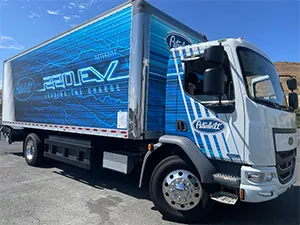
The medium-duty industry is estimated to be slightly more than 100,000 trucks, Jim Wallace said. (Mindy Long for Transport Topics)
“Peterbilt chose applications where EVs make sense today in the medium-duty and heavy-duty segments, so it’s not surprising to see them selling similarly,” he said, adding that Peterbilt has EVs in the real world working in a diverse range of geographic deployments, such as Anchorage, Alaska, and Phoenix.
One of the challenges for fleets operating in areas with extreme weather is that it can reduce range, so companies need to plan their route range carefully.
“It works the best when customers keep the vehicles indoors in cold environments or in shade in hot environments when not in use. That way, the truck doesn’t have to use its energy for cooling or heating the batteries instead of for work,” Patrick Wallace said.
EV sales are highest in states that have adopted the Advanced Clean Trucks rule. The regulation already is in effect in California and requires manufacturers to sell zero-emission trucks as an increasing percentage of their annual sales. More than a dozen states have adopted the rule. It will take effect in Maine, New Jersey, New York, Oregon and Washington next year and Vermont in 2026.
Greenhouse Gas Phase 3 requirements take effect in 2027, which could lead to more universal adoption of EVs throughout the U.S.
“The 2027 GHG Phase 3 effectively almost acts like ACT, so that will force us to sell a certain number of vehicles nationwide,” Patrick Wallace said. “This can be challenging. It is intimidating. It is a brand-new technology.”
Jack Lewis, senior vice president of truck sales and dealer operations at Hunter Truck, which operates dealerships in New Jersey, New York, Pennsylvania and West Virginia, said the dealership is working to educate customers about upcoming regulatory requirements.
“Customers don’t believe us,” he said. “We’re trying to make it easy for them because it can seem confusing.”
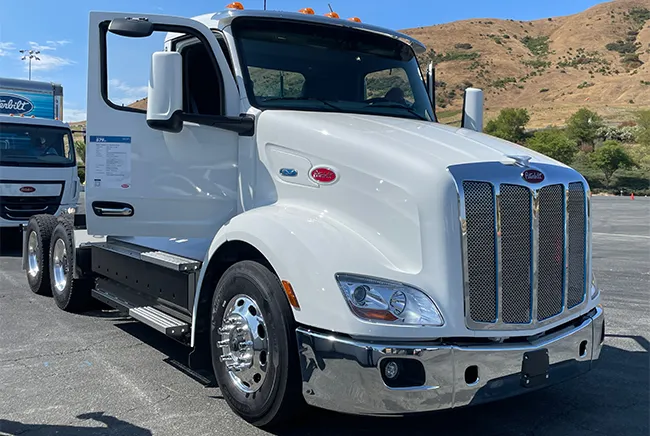
A Peterbilt 579. (Mindy Long for Transport Topics)
Hunter Truck has appointed a director of electric vehicle sales and holds customer events to share information.
“We’re trying to find the routes that work for them,” Lewis said, adding that securing EV sales is essential for the dealership to be able to sell diesel trucks. “We can sell 69 diesels in New Jersey and New York. We need to sell 250 to 275, so we’re not there yet.”
Peterbilt sees itself as a full deployment partner, addressing everything from grant funding, chargers, infrastructure installation and routing to aid in adoption.
“We come in as a team and consult a customer on where the EV will reside geographically, how far it needs to go, how long it can charge, etc., to determine a successful deployment,” Patrick Wallace said. “Sometimes we also loan the customer a truck from our sales demo fleet so they can try before they buy.”
The cost of EVs, which is double or more than a diesel equivalent, is an issue for fleets. Grant funding is critical to adoption, and Peterbilt’s dedicated grant writers assist fleets with funding for grants and chargers. “EVs are expensive due to the early nature of the technology and lower volumes, and grants help get the cost of the vehicle closer to diesel levels,” Patrick Wallace said.
One of the benefits of EVs is that they use inexpensive fuel, especially in parts of the U.S. that have low electricity costs. Peterbilt has a total cost of ownership calculator on its website.
“If you get the right grants, you can come out ahead and get a lower cost per mile with an EV than a diesel truck,” he said.
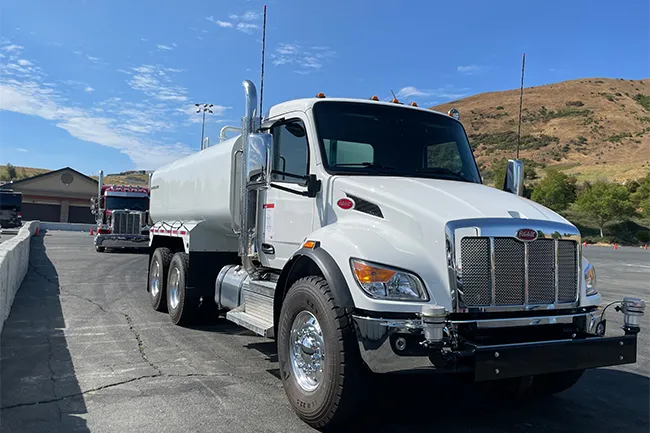
Peterbilt shared its latest initiatives and demonstrated several models of electric and diesel trucks at its 2024 Commitment to Class event Aug. 7-9. (Peterbilt)
Charging infrastructure installations have long lead times and can create a barrier to adoption, so fleets should start the planning process early. A low-power charger can be completed in about nine months, while a medium-power charger can take more than 15 months. Installing power cabinets to charge multiple heavy-duty tractors simultaneously can take up to two years.
“A higher power level increases the design and project scope,” Patrick Wallace said. “To help with both scenarios, we sit down with the customer, our sister division Paccar Parts, and our infrastructure partners to determine a timeline for EV deployments and then recommend the appropriate equipment today and in the future.”
The power needed to charge a medium- or heavy-duty truck can be significant. An average household over 24 hours will use about 35 kilowatt hours. After one run, the Class 8 Model 579 EV uses 400 kilowatt hours during a three-hour charging period.
“That is a lot of energy and a lot of power compared to a house. This requires a large charger and a large infrastructure,” Patrick Wallace said.
Not surprisingly, California-based companies are among those most interested in EVs, but deployment could be easier in other states.
“Electricity is cheaper, and the utilities aren’t as backed up,” Patrick Wallace said.
During the 2024 Commitment to Class event, Tiffany Cavazos, medium-duty marketing manager, told dealers and fleets they also need to be aware of CARB’s low-nitrogen oxide regulation, which further reduces the maximum NOx threshold for all combustion engines. The regulation took effect in California this year. Massachusetts and Oregon will sign on in 2025. Washington, New York and Vermont will adopt the regulation in 2026.
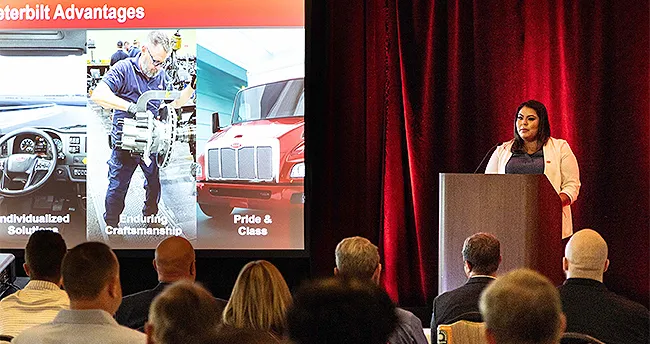
Tiffany Cavazos tells dealers and fleets they also need to be aware of CARB’s low-nitrogen oxide regulation. (Peterbilt)
“In 2027, a few more states have agreed to adopt, but this is a moot point because EPA and CARB have agreed to align in 2027. That means that all new trucks sold in all 50 states will be required to have a low-NOx engine,” Cavazos said.
Rush Enterprises CEO W.M. Rush said the company, which operates 200 locations throughout the U.S., has not seen any significant pre-buy activity related to 2027 emissions regulations, and “we do not expect that to begin until 2025.”
Lewis said Hunter Trucks plans to pre-buy equipment in mid-2025 ahead of the 2027 emission regulations to meet anticipated customer demand, but that comes with risk.
No matter what vehicles fleets buy and operate, Jim Wallace said Peterbilt is focused on reducing dwell time and has added about 100 locations and 1,000 service bays over the past 10 years. It also extended operating hours and added 950 mobile service vehicles to its fleet and 1,400 technicians since 2015.
“This has resulted in an additional 4½ hours of service per week, on average,” he said.
Want more news? Listen to today's daily briefing below or go here for more info:


